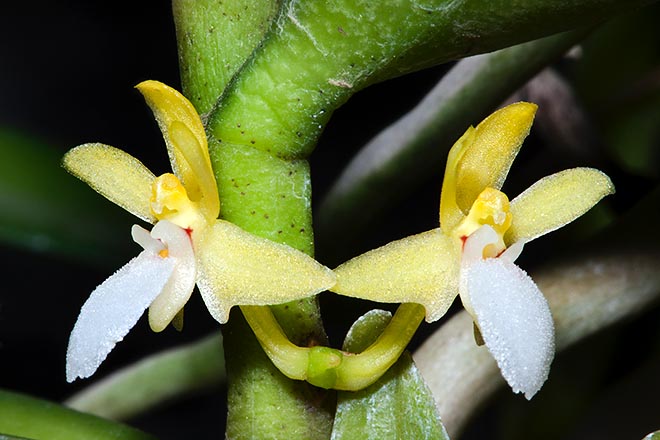Family : Orchidaceae

Text © Pietro Puccio

English translation by Mario Beltramini

The Trichoglottis bipunctata is an epiphytic mini-orchid, rare in cultivation © Giuseppe Mazza
The name of the genus is the combination of the Greek terms “thrix” = hair and “glotta” = tongue, with reference to the hairs present on the labellum; the name of the species is the combination of the Latin adverb “bis” = twice, and “punctatus, a, um” = dotted, with reference to the purple dots on the labellum.
The Trichoglottis bipunctata (E. C. Parish & Rchb.f.) Tang & F. T. Wang (1951) is an epiphytic monopodial orchid with thin cylindrical stems, of about 0,4 cm of diameter, ascending, with numerous alternate, distichous and linear leaves, about 12 cm long and 0,8 cm broad.
Inflorescences from several nodes at the same time, short, carrying 1-2 flowers of about 0,7 cm of diameter, with yellow sepals and petals and white labellum, scented. Oblong-lanceolate sepals, about 0,4 cm long, oblong-linear falcate petals, slightly smaller than the sepals, trilobed labellum with 0,2 cm long spur perpendicular to the column, oblong lateral lobes truncated at the apex, erect, 0,1 cm long, speckled of purple and median lobe ovate-lanceolate, 0,5 cm long and 0,25 cm broad, with two short purple strips at the base. It reproduces by seed, in vitro, and by division.
Mini-orchid, rare in cultivation, it requires medium-high temperatures with winter lowest values not under the 15 °C, a luminous position, but avoiding the direct sun, in particular that of the central hours of the day, and constant high humidity, 60-80%; a good ventilation is essential. Regular and abundant waterings during the growth period, rather reduced in winter when in vegetative stasis. For the waterings and the nebulisations, rainwater is to be used, or water obtained by reverse osmosis or demineralised; the fertilizations, duly distributed and alternated, in way to avoid salts accumulation at the roots, are to be done during the vegetative period preferably with hydro-soluble balanced products, with microelements, at ¼ of the dosage suggested on the package. It is to be preferably mounted on trunks, bark or cork raft, of appropriate size, in order to second its ascending posture.
The species is reported in the appendix II of the CITES (species whose trade is internationally ruled).
Synonyms: Saccolabium bipunctatum E.C.Parish & Rchb.f. (1874); Cleisostoma bipunctatum (E.C.Parish & Rchb.f.) Hook.f. (1890); Gastrochilus bipunctatus (E.C.Parish & Rchb.f.) Kuntze (1891); Saccolabium miserum Ridl. (1896); Trichoglottis misera (Ridl.) Holttum (1947).
→ For general notions about ORCHIDACEAE please click here.
